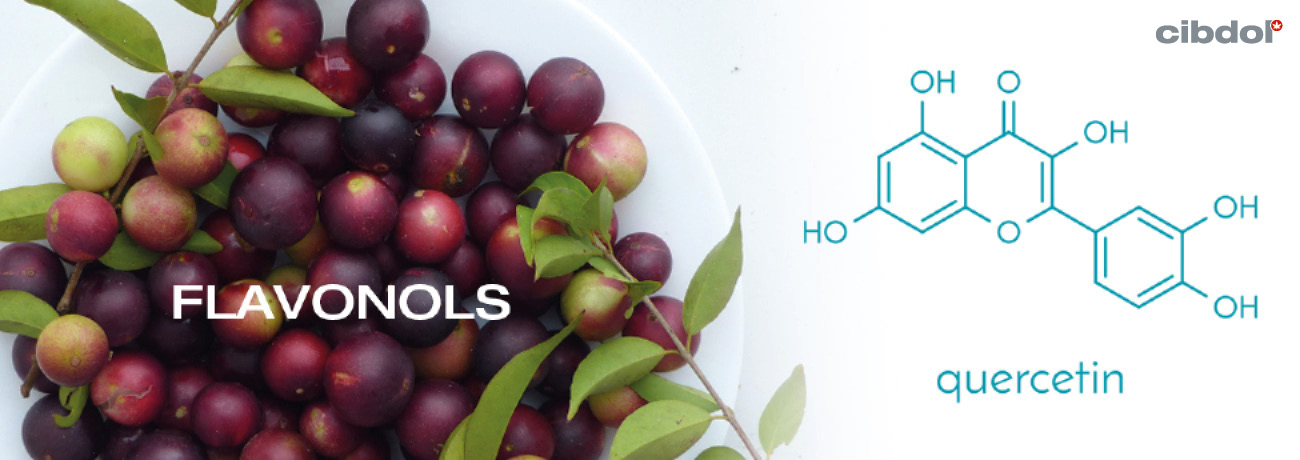What Are Flavonols?

Flavonols are a group of molecules belonging to the larger "flavonoid" chemical class. Modern science has studied flavonols to a high degree, with the most researched examples being kaempferol, quercetin, myricetin, and fisetin.
Alongside cannabinoids, terpenes, and other compounds, flavonols are thought to contribute to the overall therapeutic potential of the cannabis plant phytocomplex. Flavonols occur in various other plants too, including fruits, vegetables, and herbs, where they play important biological roles[1].
Colour
Among other duties, flavonols play a role as pigments in plants. They often produce bright yellow[2] pigmentation, which contributes to the petal colour of certain flowers, in combination with other pigments such as carotenoids and anthocyanins. This eye-catching yellow shade has been harnessed as a dye by humans throughout history.
Also found in
Flavonols occur in particularly high concentrations in:
• Onions
• Scallions
• Kale
• Broccoli
• Apples
• Berries
• Teas
• Red wine
Plants produce large quantities[3] of these molecules in their leaves, flowers, bark, and peel. Only small amounts occur in the core and underground parts of most species (with the exception of onions).
Because of their prevalence in common foods, many people frequently ingest flavonols. However, dietary intake has proven difficult to measure due to fluctuating dietary habits between individuals.

Supporting research
A mix of cell, animal, and clinical studies detail the possible therapeutic effects of flavonols. However, research is still preliminary, which makes it hard to draw concrete conclusions. Regardless, the present data still offers valuable insight into the effects of these molecules.
The current therapeutic understanding of flavonols includes the following possible effects:
• Antioxidant
• Anticancer
• Prevention of cardiovascular disease
• Diabetes prevention
Let’s take a look at what the scientific research has to say about these effects.
• Antioxidant
A review[4] published in the World Journal of Pharmacy and Pharmaceutical Sciences details the antioxidant effects of the flavonol quercetin. The paper discusses the chemical’s ability to minimise fat oxidation, thereby helping to prevent cardiovascular and neurodegenerative diseases.
The authors also suggest that quercetin helped to reduce inflammation and DNA damage by scavenging free radicals. In turn, the flavonol reduced inflammatory proteins found in high levels in patients experiencing chronic inflammatory diseases.
• Anticancer
Quercitin's antioxidant effects also underpin the molecule’s anticancer potential. It achieves these effects—in part—by helping to protect cells against the oxidative stress caused by reactive oxygen species.
The chemical also appears to produce anticancer effects by inhibiting heat shock proteins in malignant breast cancer, leukaemia, and colon cancer cell lines. Heat shock proteins are known to improve cancer cell survival.
Quercetin has also demonstrated anticancer properties in animal models. The flavonol increased lifespan by 20% in mice injected with tumour cells. The molecule also significantly inhibited tumour growth in mice with abdominal tumours, and suppressed tumour growth in mice with breast cancer cells.
• Prevention of cardiovascular disease
Epidemiological research[5] published in The Lancet suggests that the increased dietary consumption of flavonols may decrease the risk of death from coronary heart disease. Flavonols are known to inhibit the oxidation of low-density lipoprotein (LDL), a phenomenon that contributes to coronary heart disease, atherosclerosis, and ischaemic stroke. However, the researchers address the need for further studies to confirm these findings.
• Diabetes prevention
A large case-control study[6] involving 16,835 diabetes-free participants and 12,043 diabetic patients suggests that the ingestion of flavonoids (over 608.1mg per day) slashed the risk of diabetes by 10%. Those who consumed higher levels of flavonols, in particular, experienced a lower diabetes risk.
Safety and side effects
As a common dietary constituent, flavonols are generally safe. However, research[7] does point towards possible side effects of flavonoids as a whole, including diarrhoea, iron deficiency, migraines, dermatitis, and other conditions.
[1] Pollastri, S., & Tattini, M. (2011). Flavonols: old compounds for old roles. NCBI. Published. https://doi.org/10.1093/aob/mcr234 [Source]
[2] Alihosseini, F., & Sun, G. (2011). Antibacterial colorants for textiles. Functional Textiles for Improved Performance, Protection and Health, 376–403. https://doi.org/10.1533/9780857092878.376 [Source]
[3] Aherne, S., & O’Brien, N. M. (2002). Dietary flavonols: chemistry, food content, and metabolism. Nutrition, 18(1), 75–81. https://doi.org/10.1016/s0899-9007(01)00695-5 [Source]
[4] Shrivastava, N. (2012). A review of quercetin: Antioxidant and anticancer properties. ResearchGate. https://www.researchgate.net/publication/267333748_A_review_of_quercetin_Antioxidant_and_anticancer_properties [Source]
[5] Hertog, M. G., Feskens, E. J., & Kromhout, D. (1997). Antioxidant flavonols and coronary heart disease risk. The Lancet, 349(9053), 699. https://doi.org/10.1016/s0140-6736(05)60135-3 [Source]
[6] Higdon, J. (2005). Flavonoids. Oregon State University. https://lpi.oregonstate.edu/mic/dietary-factors/phytochemicals/flavonoids [Source]
[7] Martinez, S. E., Davies, N. M., & Reynolds, J. K. (2012). Toxicology and Safety of Flavonoids. FLAVONOID PHARMACOKINETICS, 249–280. https://doi.org/10.1002/9781118468524.ch6 [Source]
[1] Pollastri, S., & Tattini, M. (2011). Flavonols: old compounds for old roles. NCBI. Published. https://doi.org/10.1093/aob/mcr234 [Source]
[2] Alihosseini, F., & Sun, G. (2011). Antibacterial colorants for textiles. Functional Textiles for Improved Performance, Protection and Health, 376–403. https://doi.org/10.1533/9780857092878.376 [Source]
[3] Aherne, S., & O’Brien, N. M. (2002). Dietary flavonols: chemistry, food content, and metabolism. Nutrition, 18(1), 75–81. https://doi.org/10.1016/s0899-9007(01)00695-5 [Source]
[4] Shrivastava, N. (2012). A review of quercetin: Antioxidant and anticancer properties. ResearchGate. https://www.researchgate.net/publication/267333748_A_review_of_quercetin_Antioxidant_and_anticancer_properties [Source]
[5] Hertog, M. G., Feskens, E. J., & Kromhout, D. (1997). Antioxidant flavonols and coronary heart disease risk. The Lancet, 349(9053), 699. https://doi.org/10.1016/s0140-6736(05)60135-3 [Source]
[6] Higdon, J. (2005). Flavonoids. Oregon State University. https://lpi.oregonstate.edu/mic/dietary-factors/phytochemicals/flavonoids [Source]
[7] Martinez, S. E., Davies, N. M., & Reynolds, J. K. (2012). Toxicology and Safety of Flavonoids. FLAVONOID PHARMACOKINETICS, 249–280. https://doi.org/10.1002/9781118468524.ch6 [Source]







